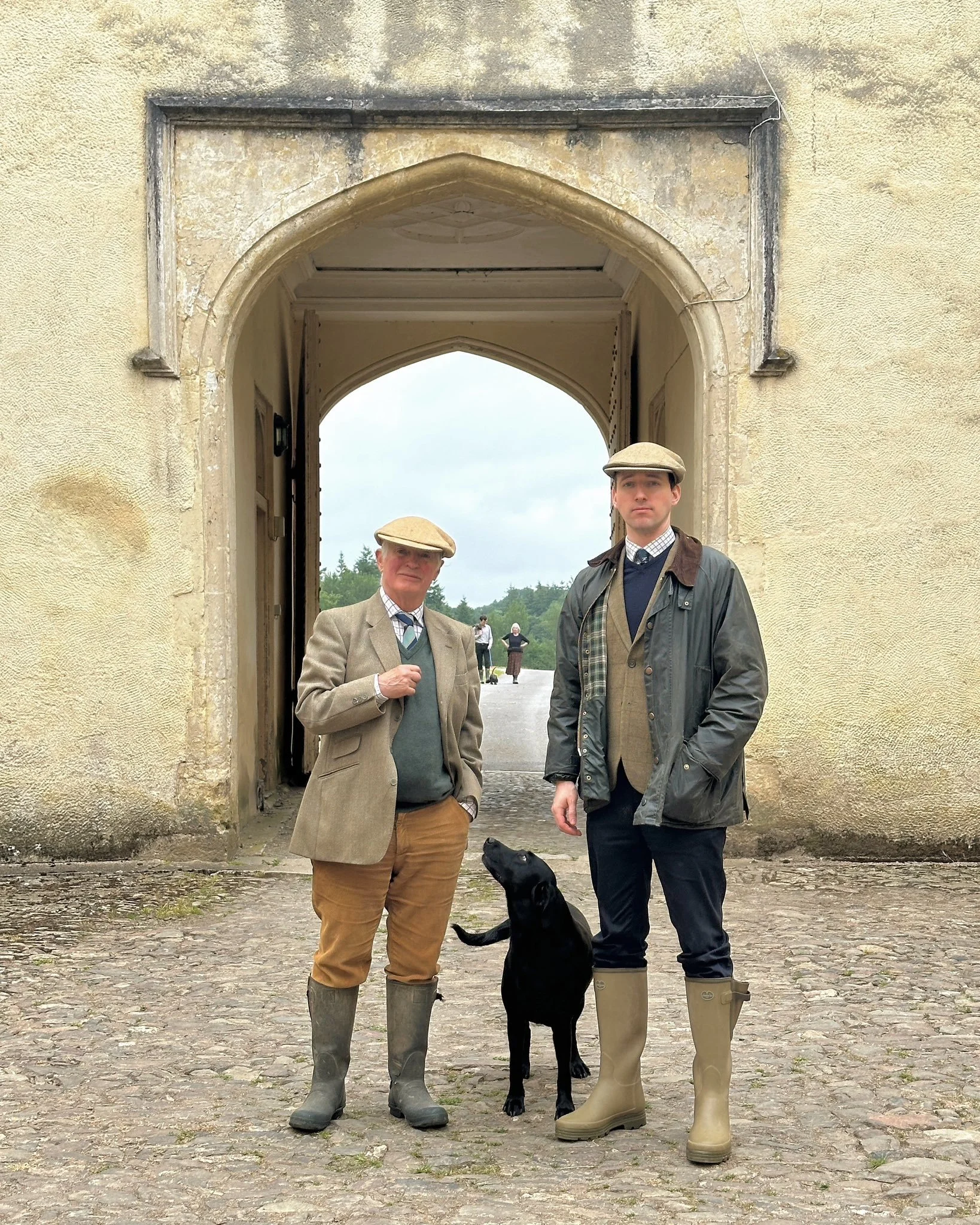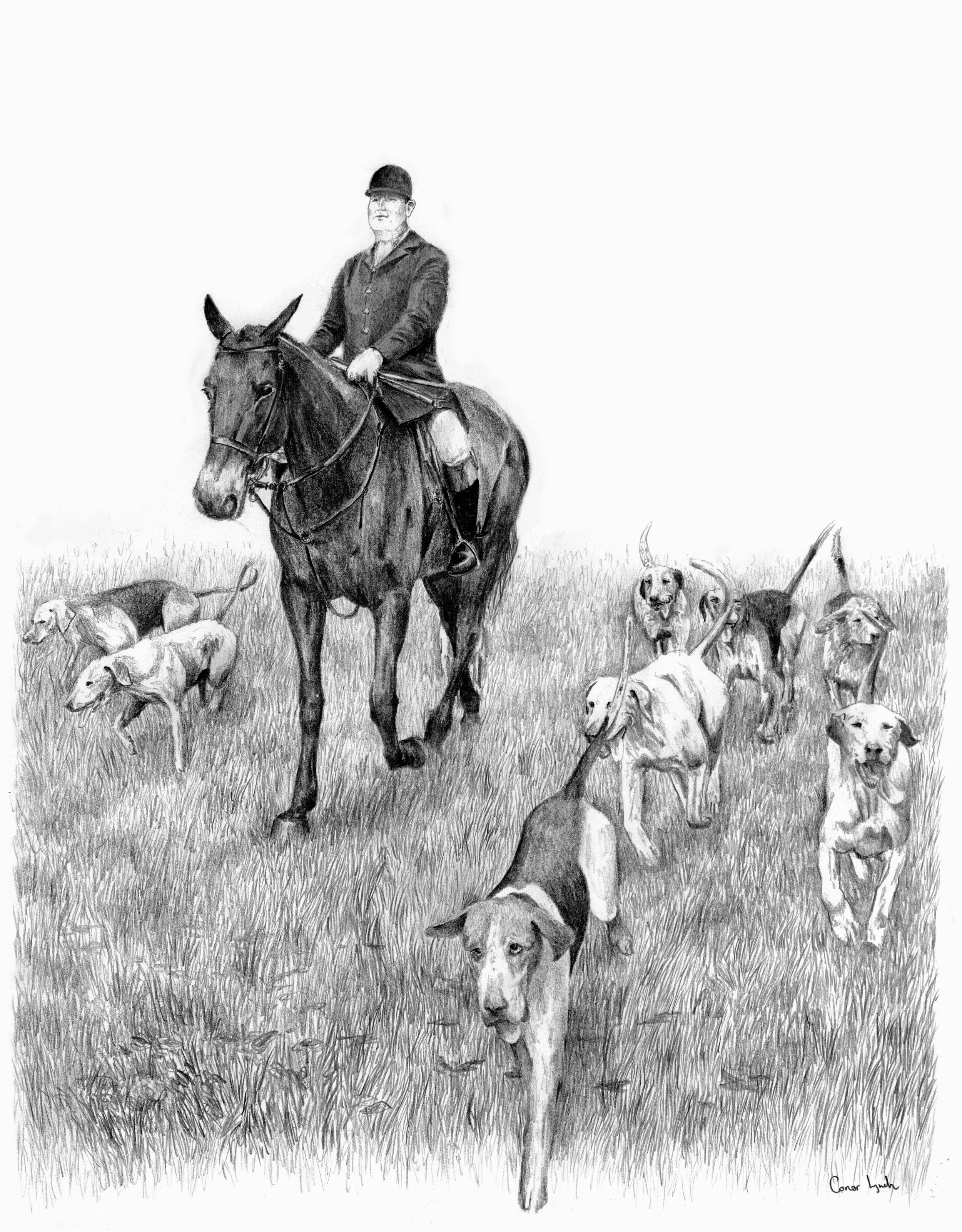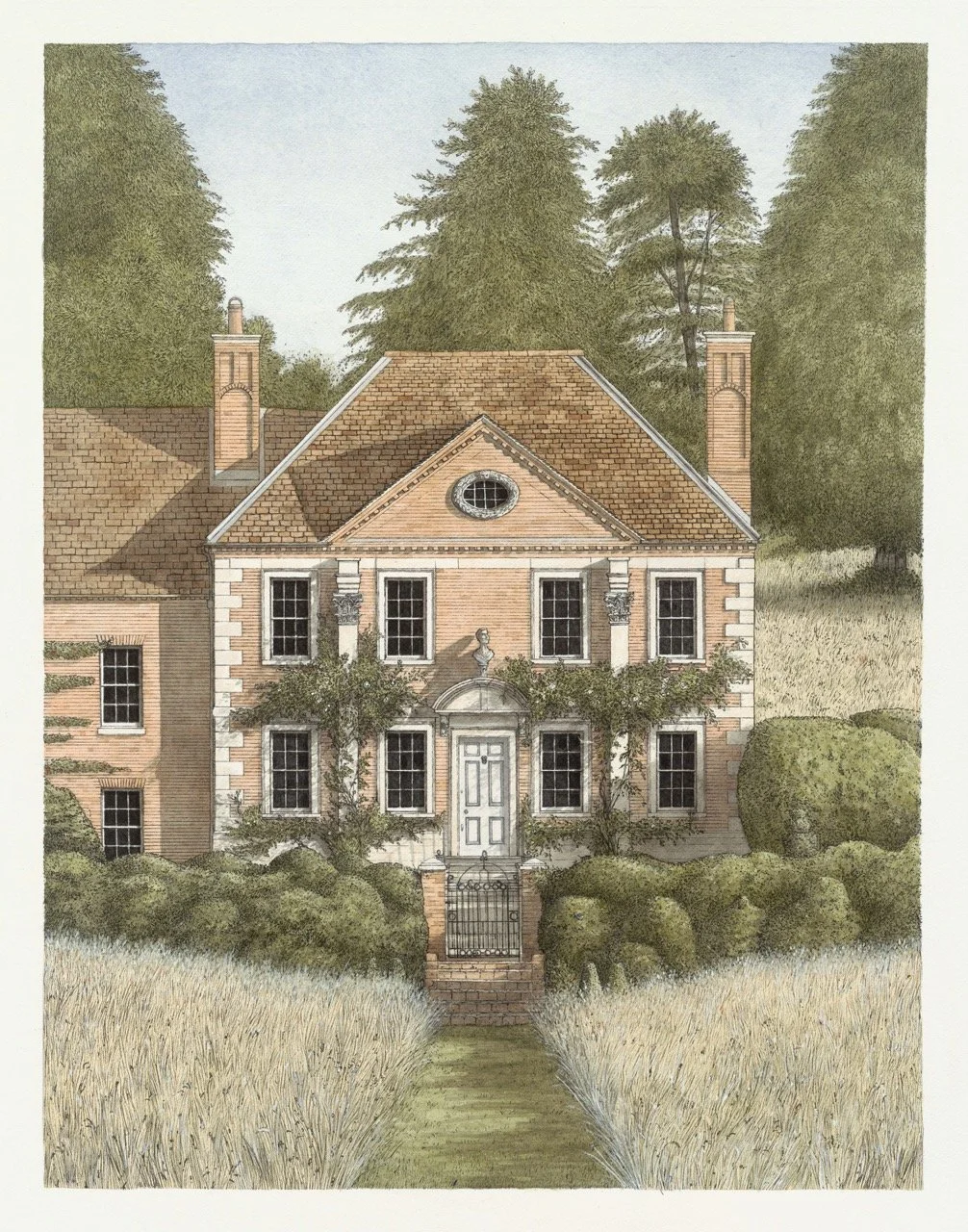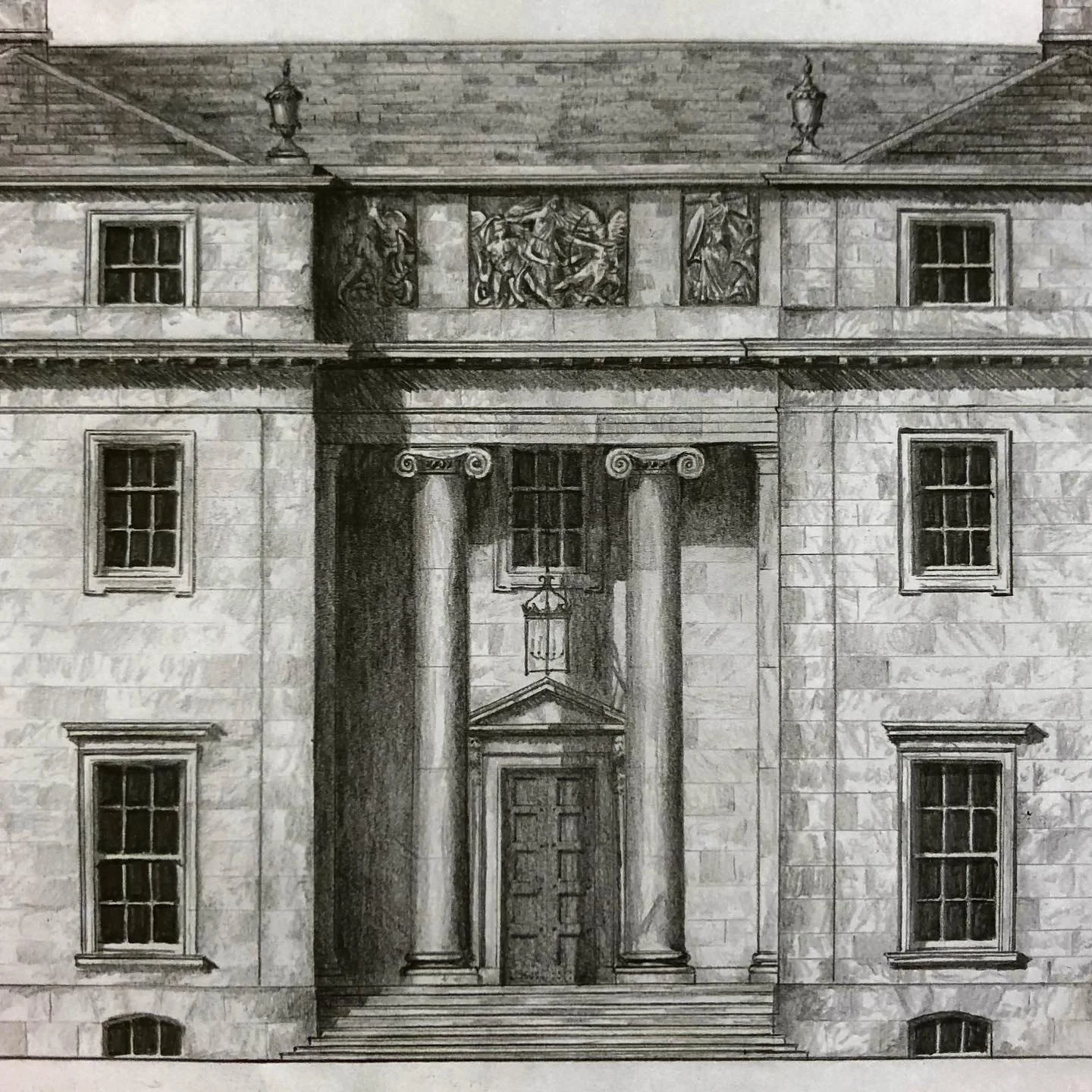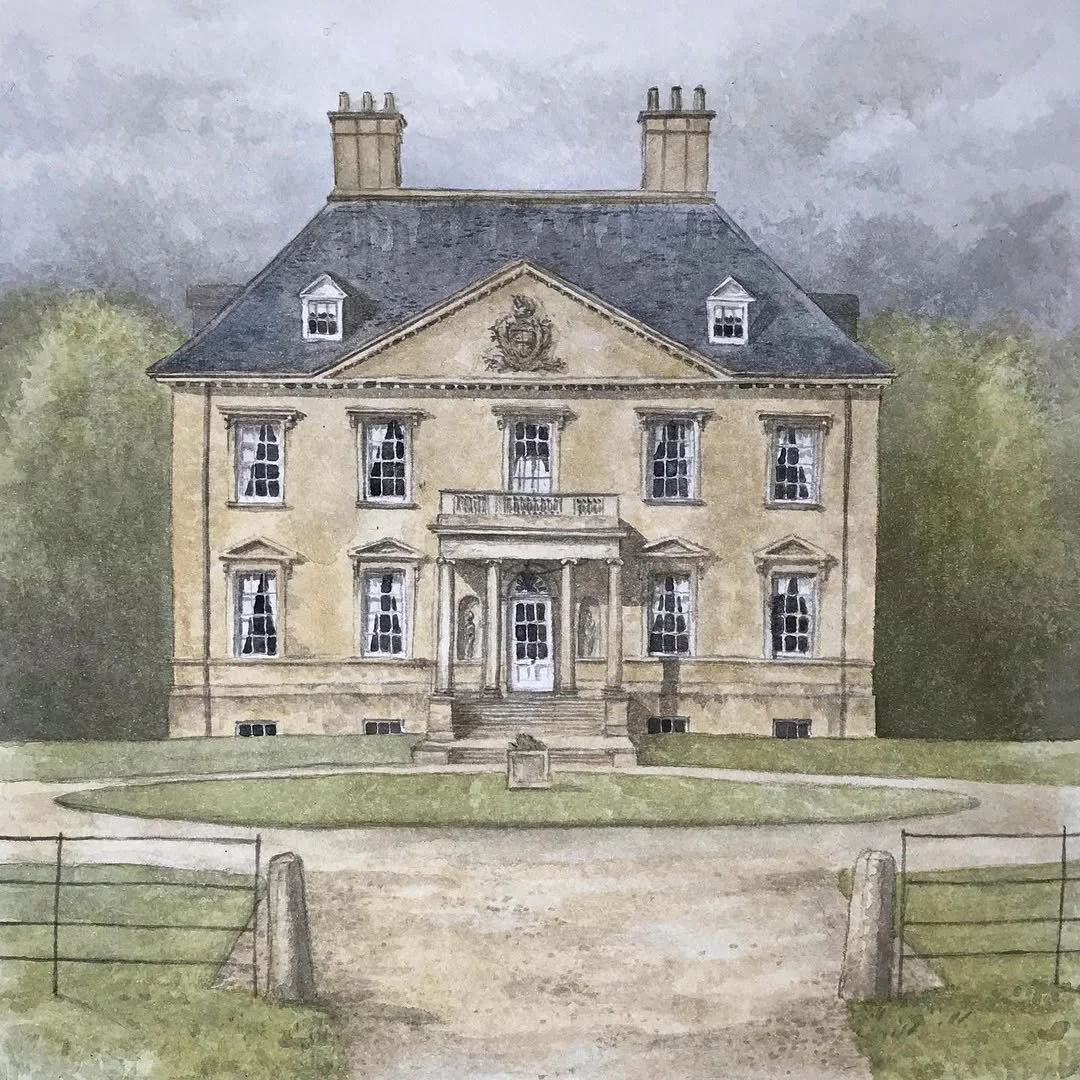
GREAT HOUSES & ESTATES
CRAFTING TIMELESS ARCHITECTURE FOR THE EQUESTRIAN LIFESTYLE
In a fast-paced world characterized by fleeting trends, Conor Lynch stands as a thoughtful advocate for timeless design. As the founder of Great Houses and Estates, an influential platform dedicated to the enduring beauty of classical architecture and rural estate life, Lynch has carved out a unique voice that bridges tradition and modernity. With deep reverence for craftsmanship, proportion, and permanence, his work—both built and drawn—offers a reminder that elegance is not a trend, but a language passed down through generations.
In this conversation, we explore the principles that guide his architecture, the soulful stories behind his evocative pencil drawings, and why the classical tradition continues to resonate in the 21st century—especially in the equestrian world. Whether designing a Georgian stable block or restoring a centuries-old country house, Lynch brings to each project a rare sense of stewardship, civility, and grace.
"These houses are not museums, though their contents might well rival those in national collections. What makes them so special is that they are still homes."
-Conor Lynch
Personal Background
What first inspired your fascination with country houses? Was there a particular place, book, or mentor that lit the spark?
I’ve been visiting country houses since I was a child. There was something utterly captivating about them - their eclectic layers, the sense of mystery, and the way they seemed to hold living history within their walls. These houses are not museums, though their contents might well rival those in national collections. What makes them so special is that they are still homes. There are dogs, children, books left half-read, fires burning in the grate - there’s life, and that life keeps the past alive in a way that no velvet rope ever could. There is a sense of continuity and tradition.
A formative figure in this fascination has been Lord Meath of Kilruddery House, whom I’ve come to regard as something of an elective grandfather. My own paternal grandfather died when my father was a boy, and my maternal grandfather passed away when I was a child.
Lord Meath, with his deep love for the countryside, trees, birds, architecture, and tradition, became a guiding influence. He helped deepen my appreciation for estate life - not only its beauty, but its responsibilities.
Another influence was the landowner Francis Fulford, whose book Bearing Up I always recommend. It’s a witty, candid account of what it means to run an estate today - the trials, the quirks, and the enduring commitment to a way of life that remains anchored in the land. It’s a reminder that these houses are not relics. They are dynamic, often difficult, but profoundly human undertakings.
Equestrian Lifestyle & Design
Tell us about the Georgian stable block you designed. What traditions inspired it, and what did you want it to express?
The stable block is built in the Georgian tradition, which I believe still holds the greatest elegance and civility. I based the overall composition on Palladian principles: a central pedimented block with long symmetrical wings on either side. This tripartite form is one of the most enduring in classical architecture, and with good reason - it conveys order, strength, and a quiet grandeur.
But beyond architecture, I wanted the building to express something deeper about the equestrian life. Horses are not simply animals we keep - they are animals we share our lives with. They have an immense physical presence, and there’s a kind of nobility in that. They are full of character, yet also rather silent. I wanted the building to reflect that dignity.
The central block houses the tack room and feed room, while the flanking wings hold the stalls. The scale of the doors, the generous overhang of the eaves, the rhythm of the openings—each was carefully considered to feel calm, timeless, and in proportion with the horses themselves. This is not a pastiche or a nostalgic gesture; it is a living building in a living tradition.
What makes for a beautifully designed stable yard—not just functional, but aesthetically satisfying?
The same principles that govern the design of a good country house apply equally to the stable yard: balance, harmony, and rhythm. A well-designed yard has a sense of repose. It is not busy, nor cluttered, but composed. The arrangement of buildings should have a natural logic - perhaps a central axis, or a framing of views - so that every element supports the whole.
Proportion is especially important. Too often, modern stable buildings are either too low and apologetic, or too large and aggressive. Horses are powerful, graceful creatures - they deserve architecture that meets them in kind. A well-proportioned stable gives the horse space, but also sets a tone: one of dignity.
Material is important too; render, brick, stone. The roofline, the eaves, the guttering - all these details contribute to the overall expression of the yard. Beauty in a working yard is not an extravagance - it is a mark of respect, for the horses and for the life lived with them.
Why does the equestrian lifestyle pair so naturally with classical design?
Because both are concerned with discipline and grace. A well-schooled horse is like a well-proportioned building: it moves with purpose and elegance, grounded in training but expressive in form.
There is also a historical depth to this connection. Horses and classical architecture have long been intertwined - on country estates, in military traditions, and in the visual arts. From the equestrian statues of Antiquity to the stable blocks of great houses, the horse has always had a place within the classical world.
But more than anything, I think it comes down to the values they share. Horsemanship, at its best, is not showy - it is controlled, precise, deeply felt. Classical architecture is the same. It has no need to shout. It speaks through proportion, through shadow, through stillness. That’s why they belong together.
Architecture & Design
Your pencil drawings are incredibly detailed and atmospheric. How do you approach drawing a house? Are you telling a story, capturing a feeling, or both?
Both. A house is more than its elevation - it lives through light and shadow. The way a moulding catches the sun, or how stone ages under wind and rain - these are the things that give a classical building its soul. My drawings aim to capture that.
In order to understand this tradition properly, I spent years measuring and drawing houses I found beautiful. Through that process, their beauty entered into my own work. I trained my eye according to what had already stood the test of time.
The play of darkness - particularly in the windows - adds not just realism, but depth and atmosphere. It lends a slight ethereality to the house, elevating it into an ideal. A drawing is a kind of reverence, and I try to present the house as it ought to be seen: timeless, poised, full of presence.
What architectural features distinguish a truly great estate house from a merely large one?
A great estate house is not defined by its size or cost, but by its composition and proportion. Harmony between parts is everything. How does a window relate to the wall? What is the ratio between column and cornice? How are the openings spaced? The composition of the façade? These are the questions that shape a great building.
Understanding the Classical Orders gives an architect a powerful framework. A great talent might produce a masterpiece, yes - but even a modest practitioner, trained in this tradition, can create a dignified, handsome house. It all comes down to the eye: how well it has been trained, and how attuned it is to balance and rhythm.
A great house is composed with care. Every detail belongs to the whole. That’s what gives it its grace.
How do you approach designing or restoring a country house in a way that respects heritage but makes sense for 21st-century life?
I approach a house as though in conversation with its original architect. Additions should feel like natural extensions - organic, respectful, and entirely in character with the spirit of the house. Ideally, a new wing or restoration should be indistinguishable at first glance: people should wonder whether it was always there.
There are cases, of course, where a complementary variation in style is appropriate. But the goal is always the same: to elevate the original, never to overshadow or weaken it. A successful design enhances its context. If someone says, “Is this a restoration?”- that, to me, is the highest compliment.
How do classical principles continue to influence modern country house design?
Classical principles endure because they are, quite simply, eternal. They have evolved organically over millennia - not invented all at once, but rather shaped by the accumulated wisdom of countless generations. Their strength lies in adaptability: they can evolve to meet the changing needs of different ages while remaining grounded in something permanent and deeply human.
We look to Antiquity not as a rigid blueprint, but as a way of rediscovering our own tradition. Classical architecture is a visual language - one that cannot truly be learned from a textbook. It must be drawn, measured, and studied in the flesh. Its grammar lies in the orders, mouldings, and proportions; its poetry lies in the way those elements come together to speak across time. In that sense, classical architecture expresses something more ancient than even the written word. It reaches into our ancestral memory and speaks of permanence, harmony, and beauty. It carries the language of our earliest form of shelter – from the primitive hut to the great temples.
What it offers today is exactly what people have always wanted in a home: strength, grace, and a sense of rootedness. A classical house can face the weather, withstand time, and still feel as fresh to future generations as it does now. Its beauty is never fleeting - it speaks to all ages.
How did “Great Houses and Estates” begin? Did you envision it as a platform for storytelling as well as architecture?
I launched Great Houses and Estates in September 2024 with the simple aim of sharing my passion for these places - and it has since grown into something far greater than I ever imagined. We’ve now reached nearly half a million followers, and what draws people in, I think, is not just the architecture, but the way of life these houses represent.
That way of life is rooted, purposeful, and full of meaning. Unlike a purely commercial farm, the estate landscape allows for a mix of uses - there are working areas, yes, but also pleasure grounds, parkland, and wild corners where nature is left to its own rhythm. There’s space not only for productivity but for reflection and beauty.
The houses themselves are repositories of craftsmanship. Their contents span centuries of national creativity, and their ancestral portraits tell the stories of continuity - through good times and bad. The staff, too, are often deeply tied to the land and have known the family for generations. There is a sense of stewardship, of belonging, of civilisation in the truest sense of the word.
The old saying that “civilisation is when an old man plants a tree under whose shade he will not sit” rings very true in these places. Landowners think in decades and centuries. It’s a slower rhythm, but a richer one - and Great Houses and Estates is my way of celebrating that.
What do you hope your American audience takes away from your keynote in October —particularly those unfamiliar with the depth of British rural tradition?
I hope they leave with a sense of the enduring values embedded in the British countryside - of land held not merely as an asset, but as a trust between generations. There’s a remarkable continuity here: the land, the families, the architecture, and the traditions are all woven together in ways that are subtle but deeply meaningful.
We live in an age of impermanence and speed. The estate life is the opposite - it’s rooted, generational, and travels at a slower pace. The landowner is a custodian. The estate staff are part of the extended family. And the house, if cared for properly, becomes more than a structure - it becomes a vessel for memory, beauty, and responsibility.
Follow Conor Lynch on Instagram @greathousesandestates & @c_k_lynch
Email: conorklynch@gmail.com



